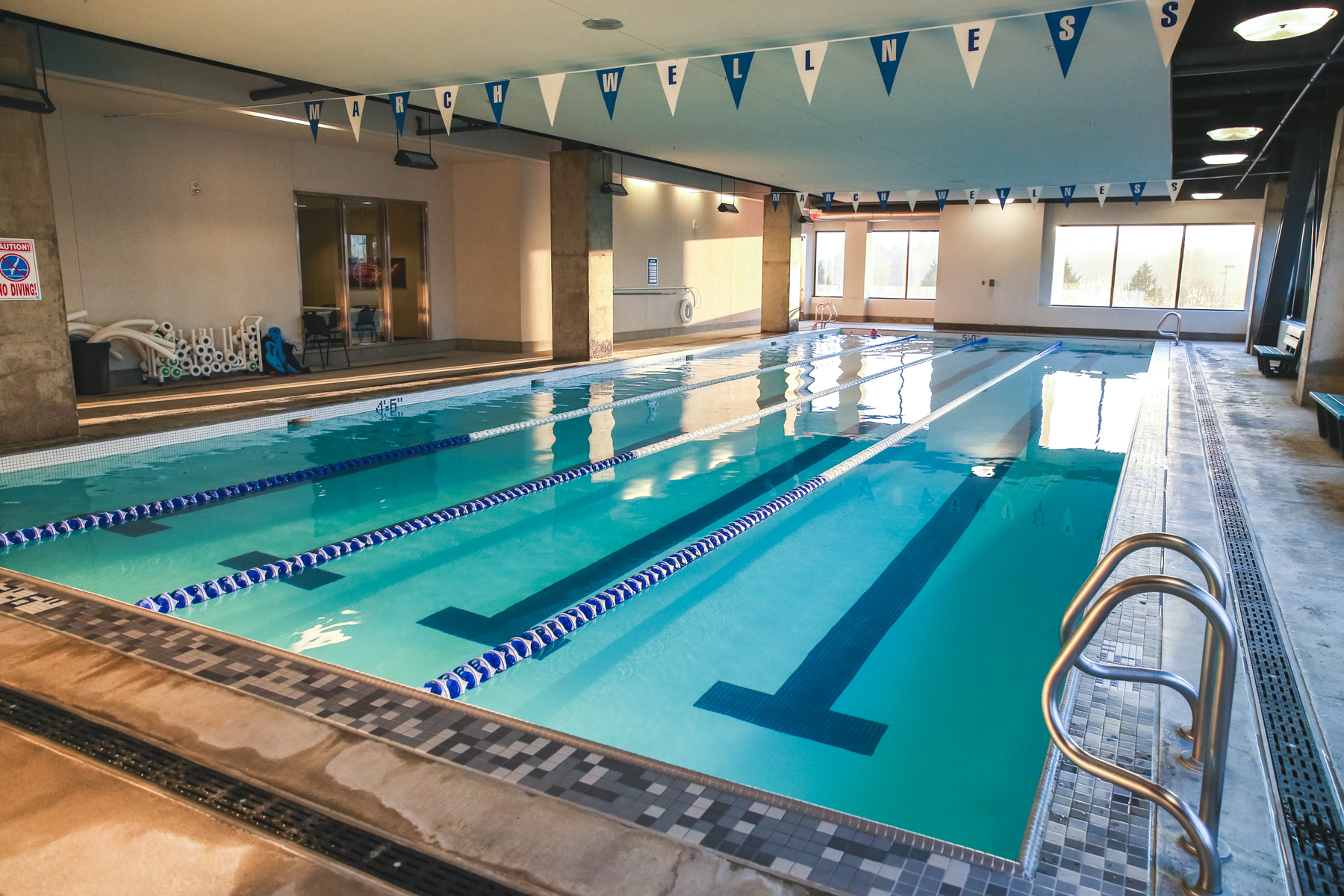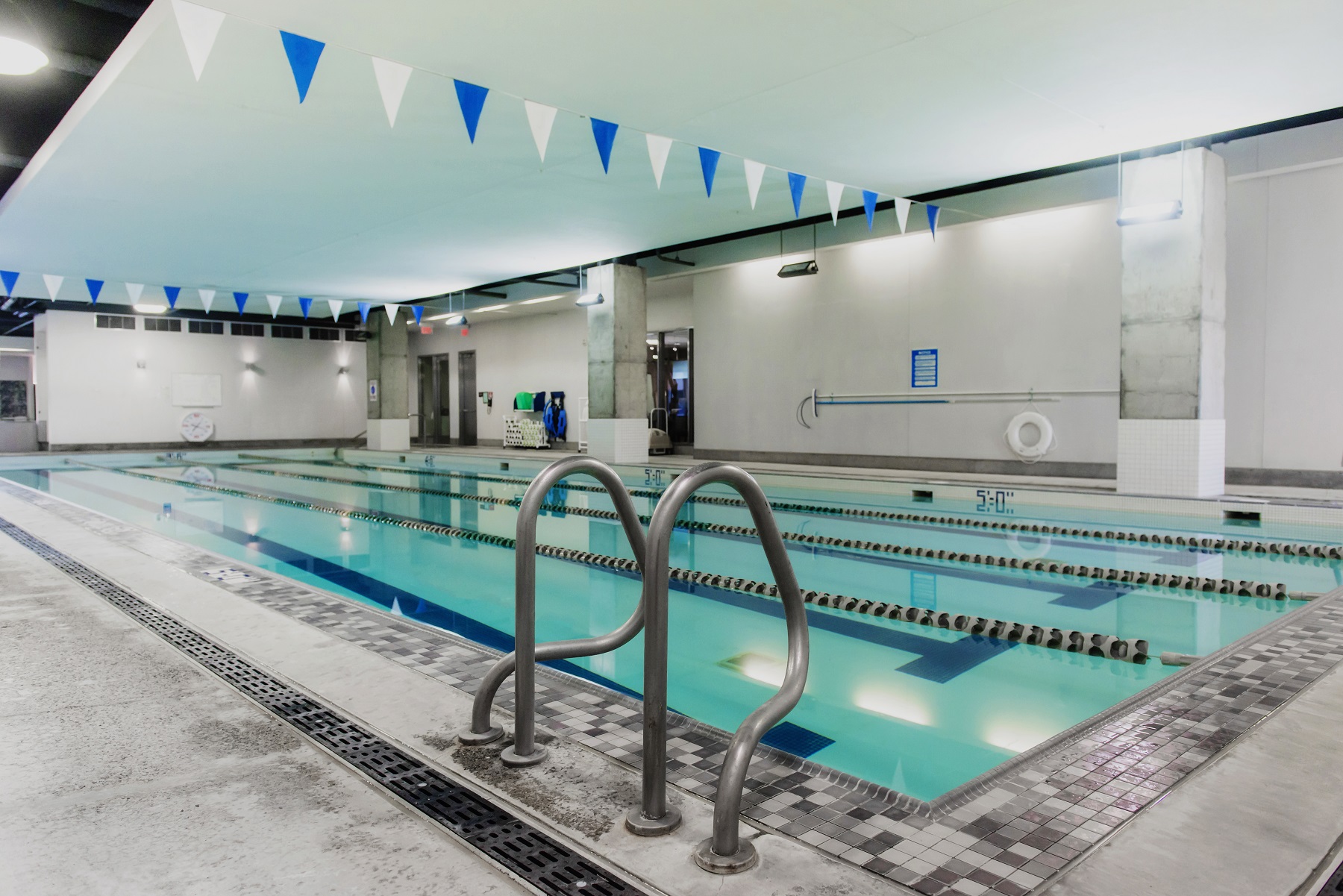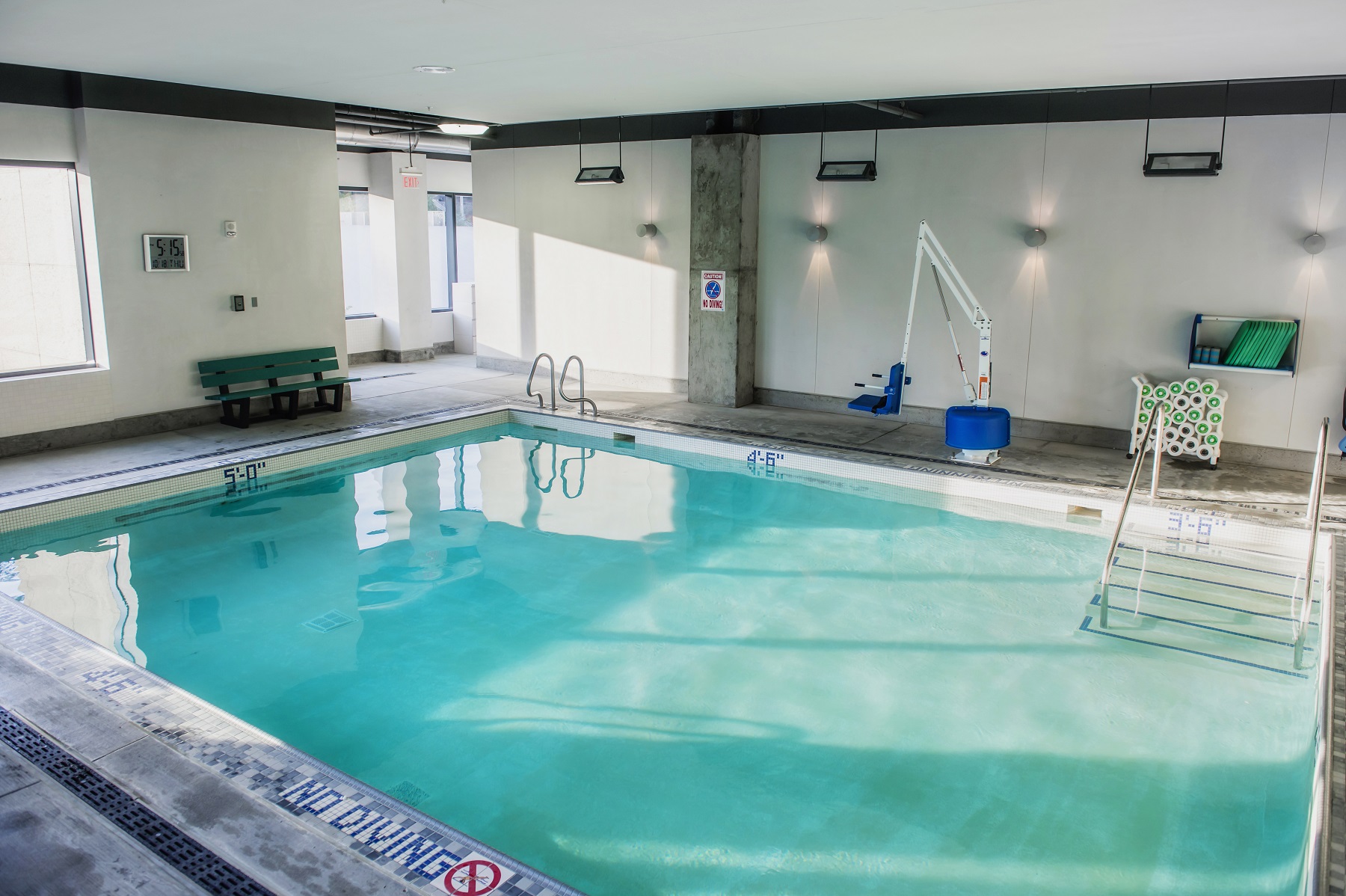Pools

Lap pool
march wellness & fitness center provides three water features: a lap pool, a warm water therapy pool and a large-capacity whirlpool spa. Each uses a sophisticated salt purification system, rather than a traditional chlorine purification system. The salt is far gentler to your skin, hair, eyes and swimsuit and provides an experience that's more like swimming in a lake than a chlorinated pool. In addition, steam rooms and dry saunas are available in the men's and women's locker rooms for relaxation after a challenging workout or a stressful day.
The lap pool is 25 yards in length and provides a dramatic view of the beautiful Willamette River and South Waterfront district. The water is kept at approximately 82 degrees, the depth is 3'6" to 5'0".

Warm water therapy pool
The warm water therapy pool is used for low-intensity water exercise, therapeutic movement or just a warm retreat for no-impact movement. It's 24 feet by 32 feet in size, and the water is kept at approximately 92 degrees, and the depth is 3'6" to 5'0". The therapy pool is particularly good for members managing arthritis or fibromyalgia or members recovering from surgery or a serious injury that prevents them from participating in weight-bearing exercise.

Whirlpool spa
The whirlpool spa, which comfortably accommodates 15 people, provides a truly relaxing soak. The water is kept at approximately 102 degrees, and the depth is 3'6".
A mobile PAL lift is available for all pools for anyone needing assistance entering or exiting the pools. Members must be able to enter and exit lift independently or with the assistance from a caregiver. Please request the lift battery at the front desk upon entry, staff will install the battery and move lift to the desired pool.
Saline pools - the salt and CO2 story
Why salt-water?
The primary factor in their popularity is their limited use of chlorine. Unlike traditional pools, which require chlorine to be poured into the water manually or released from a tablet, a saltwater pool has a generator that uses electrolysis to release chlorine gas from salt in the water. Salt is added to the pool water to achieve a saturation of approximately 3,200 parts per million. Swimming in a mild saline solution is much like taking a shower in soft water. Generally, when people swim in a non-chlorine generator pool (a pool with no salt water in it) they feel like their skin dries quicker upon exiting the pool. They may feel and/or see white residue or chlorine flaking on the skin. In a salt-water pool (one with a chlorine generator) the water feels smooth, your skin feels smooth and many people feel more refreshed.
Here is a comparison of salt levels:
Fresh water has 1,000 ppm salt
Saline pool has 3,000 ppm salt
A tear drop has 9,000 ppm salt
Ocean water has 35,000 ppm salt
How does a saline pool work?
march wellness & fitness center uses the TMI Salt Pure® systems in all three pools. This system provides a self-contained, compact Sanitizing System, which fulfills all of a pool's sanitizing needs. This system works by producing chlorine from a small amount of salt that is added to the pool water. This process is known as "Electrolytic Generation". As salt in the water passes through a Salt Pure® cell, it converts to Sodium Hypochlorite. When any type of chlorine is added to water it ALL makes the same thing: Hypochlorous acid. It does not matter if it is Sodium Hypochlorite (liquid chlorine), Tri-chlor and Di-chlor or Lithium based, Cal-hypo or even gas chlorine--it all makes Hypochlorous acid. Hypochlorous acid is the active sanitizer which continuously shocks out chloramines and organics while maintaining the desired sanitizer level. The important distinction is that saltwater pools lack chloramines, referred to as Combined Chlorine. Chloramines are the irritants that give traditional pools the stigma of burning eyes and caustic smell. This is called a closed loop system because the salinity in the pool water is used over and over again.
The numbers below correspond to "The Chemical Reaction at Cell Diagram"
- Sodium chloride (salt) added to pool water.
- Anode of cell makes hypochlorous acid and hydrochloric acid.
- Cathode of cell makes sodium hydroxide and hydrogen gas (the hydrogen gas bubbles through the pool water into the atmosphere).
- Hypochlorous acid from the anode combines with the sodium hydroxide from the cathode to make sodium hypochlorite or liquid chlorine when mixed with the pool water going through the cell.
- Hydrochloric acid from the anode combines with the sodium hydroxide from the cathode to make sodium chloride (salt) which is re-used by the cell.
- Liquid chlorine at a pH of 7.4 goes half to hypochlorous acid and half to sodium hydroxide.
- Hypochlorous acid combines with soil, bacteria, algae, organics and UVs to convert to hydrochloric acid.
- Hydrochloric acid combines with sodium hydroxide forming sodium chloride (salt) again which is re-used by the cell.
Why CO2?
CO2 is the safest, most reliable alternative to using muriatic acid to balance the pH level of pool water. Maintaining the desired pH level of your water is critical to ensure swimmers' comfort and safety. CO2 replaces acid and is regulated by an automatic control system.
How does CO2 work?
The use of CO2 raises the total alkalinity of the water by combining with the water to form mild carbonic acid that creates a natural buffer against sudden drops in pH. Carbon dioxide plays an important role in the make up and balancing of pool water. When dissolved in water, carbon dioxide has a direct effect on the water's pH. Carbon dioxide (also known as CO2 and carbonic acid) is formed when acid is added to pool water, and it is this compound that affects the changes in the pH of pool water. Carbon dioxide (CO2) is a common, essential compound in nature. It is found almost everywhere, from what flowers and trees breathe in, to what humans and animals breathe out; and to the bubbles in the soda you drink. In its warmer phase it is a gas, and in its colder phase it becomes a solid – dry ice. In water, CO2 primarily exists as aqueous CO2 (gas in, but not fully reacted with the water). The more CO2 in the water, the lower the pH, and the less CO2 in the water, the higher the pH. Liquid carbon dioxide CO2 can play an important part in maintaining the pH levels in swimming pools. Water disinfectants like chlorine can turn the water solution alkaline. However, with the introduction of carbon dioxide, alkalinity levels can be regulated, as it forms a weak carbonic acid. By using carbon dioxide in a swimming pool you are able to reduce your reliance on mineral acids. It's a cleaner and safer alternative than muriatic acid.